
Okay, so you can’t teach your dog the trick of flossing and brushing their own teeth. However, there are still multiple ways you can keep your dog’s dental health pristine and prevent diseases.
Surprisingly, many, if not most dog owners, do not realize the importance of their dog’s oral health. By the time dog owners realize their dog has afflicted teeth after a visit to the vet, it’s too late. The dog has already been suffering from gums that are sore and infected, or loose and rooting teeth. Often dogs need to be given anesthesia to remove plaque and tartar buildup.
Although preventing diseases before they occur is the most beneficial way to approach your dog’s health (similar to humans!), it’s never too late to improve your dog’s dental health. It’s also not too early to get your dog started on good habits and behaviors when it comes to maintaining healthy teeth.
The first thing to do is to sniff your dog’s breath. Sure, it might not smell great, but if it is particularly bad, your dog’s breath could be an indicator of dental or gum disease. Poor breath could also be an indicator of a larger issue, such as respiratory problems. A foul odor combined with vomiting or a lack of appetite could point towards a problem with your dog’s liver. A “fruity”, or sweet smelling breath, and frequent urinating could be a sign of diabetes. If any of these apply, it’s best to visit the vet to check.
Once a week, it is recommended that you check your dog’s teeth by lifting his lips and examining his gums. They should be pink rather than white or red. Also, they should not be swelling. The dog’s teeth should be clean looking, without brown-colored tartar.
Just as we brush our teeth, dogs benefit from tooth brushing too. You should purchase a toothbrush that is made specially for canines. You should also purchase toothpaste for canines, or mix baking soda and water to make a paste. You should not use human toothpaste, since fluoride can interfere with enamel formation for younger dogs, and can lead to upset stomachs.
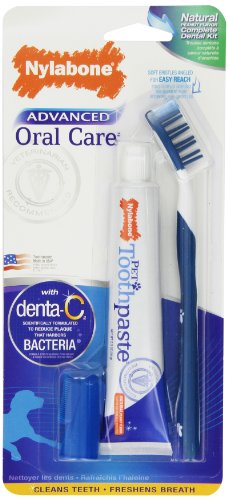 Nylabone Advanced Oral Care Natural Dog Dental Kit
Nylabone Advanced Oral Care Natural Dog Dental KitTo begin brushing your dog’s teeth, get your dog comfortable with touching her mouth. Start with small steps by massaging your dog’s lips gently for around thirty seconds, one to two times a day for a few weeks. When she is comfortable with this, move towards touching her teeth and gums.
Next, put some toothpaste for canines on your dog’s lips to get your pet accustomed to the feel and taste. After she is accustomed to this, begin using a toothbrush for canines to gently massage your dog’s teeth.
Apply toothpaste to the toothbrush and hold your brush at a 45 degree angle to the teeth. Begin by working in small, circular motions on your dog’s teeth. If needed, lift his lips and focus on one area at a time. The area most susceptible to tartar is the side touching the cheek. A good way to remove the tartar is by downwardly stroking these areas. If you dog starts to get fidgety or irritated during the process, you should stop. Try again another time. It is a good idea to comfort your dog with soothing words. A treat after process will help your dog to enjoy the process since he will associate the tooth brushing with a treat. Soon, your pet will be looking forward to getting a dental cleaning. You should aim to brush your dog’s teeth at least twice a week.
The best time to brush your dog’s teeth is after he’s had some exercise. He is more likely to sit still and not fidget around.
Provide your dog with chew toys to clean his teeth in the chewing process. Chew toys also keep his teeth strong and massage his gums. Make sure the dogs are toxin-free and safe for dogs, without small, breakable parts. For instance, some bones are brittle and can be dangerous for canines if they break off with chewing. The chew toys shouldn’t be too hard, though. An object that is too hard for your canine’s teeth can make his teeth break. Test the toy with your nail by pressing it with a fingernail. There should be a dent in the toy. If not, the toy is too hard.
It is better to give your dog dry food rather than soft food. Dry food will not stick as easily onto your dog’s teeth compared to soft food. Sticky food can contribute to tooth decay. However, if your dog prefers soft, canned food over dry food, there’s no need to take away her favorites completely. Simply alternate between soft and dry food, or mix both together, to give your dog a tasty treat that makes teeth strong. Of course, if you are introducing your dog to new foods or toys, it is best to have a chat with your vet to make sure that your dog is ready to take the next step.
There are treats for dogs that encourage chewing and are purposely designed to clean off tartar and plaque buildup. A particularly good brand is Dentastix by Pedigree. They’re an affordable alternative to other edible options and quite popular amongst many dogs. Highly recommended!
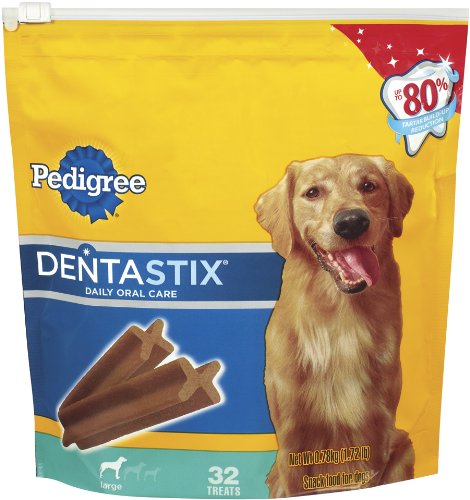 Dentastix Oral Care Treats for Dogs, Large, 1.72 lbs, 32 Count
Dentastix Oral Care Treats for Dogs, Large, 1.72 lbs, 32 CountSmall efforts each week to take care of your dog’s teeth will go a long way in preventing dental diseases and maintaining strong, healthy teeth. Good dental care saves money and heartache in the long run for both you and your dog. Vets cite the importance of dental care for a dog’s prolonged life.
Here’s a final quote that will have you thinking about the seriousness of oral hygiene for your pet from Dr. Bellows, Specialist in Veterinary Dentistry: “When a client asks me how long their puppy will live, I usually respond 15-17 years if you brush their teeth daily…11-13 years if you don’t.”
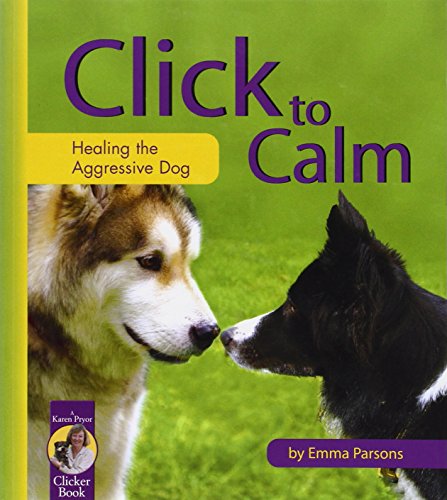 My Dog Lunges And Barks At Other Dogs
Walking your dog is a nightm
My Dog Lunges And Barks At Other Dogs
Walking your dog is a nightm
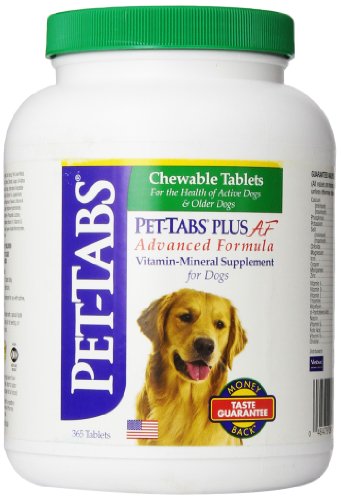 The Effects of Nicotine and Secondhand Smoke on Your Dogs
Credit: CDC (PHIL) - Public domain
The Effects of Nicotine and Secondhand Smoke on Your Dogs
Credit: CDC (PHIL) - Public domain
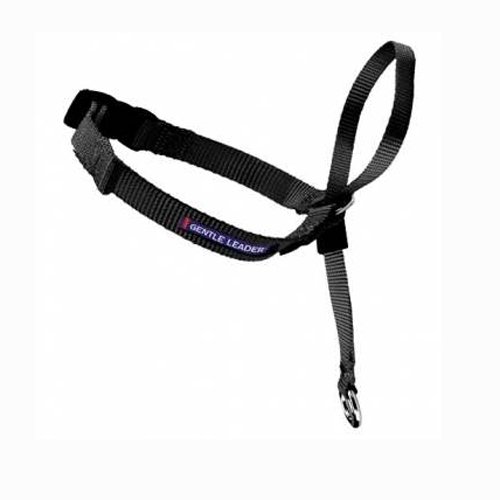 Hate to Walk Your Pulling Dog? Heres the Instantaneous Solution (Really!)
Credit: thatmutt.c
Hate to Walk Your Pulling Dog? Heres the Instantaneous Solution (Really!)
Credit: thatmutt.c
 The Evolution of Dogs: 5 critical steps in the evolution of the modern dog
5 Critical Steps in the Evolution of Dogs
The history of o
The Evolution of Dogs: 5 critical steps in the evolution of the modern dog
5 Critical Steps in the Evolution of Dogs
The history of o
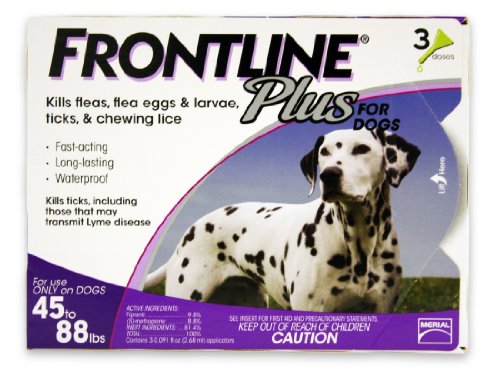 How to Relieve Your Pets Itching and Scratching
Unhealthy SkinA number of sk
How to Relieve Your Pets Itching and Scratching
Unhealthy SkinA number of sk
Copyright © 2005-2016 Pet Information All Rights Reserved
Contact us: www162date@outlook.com